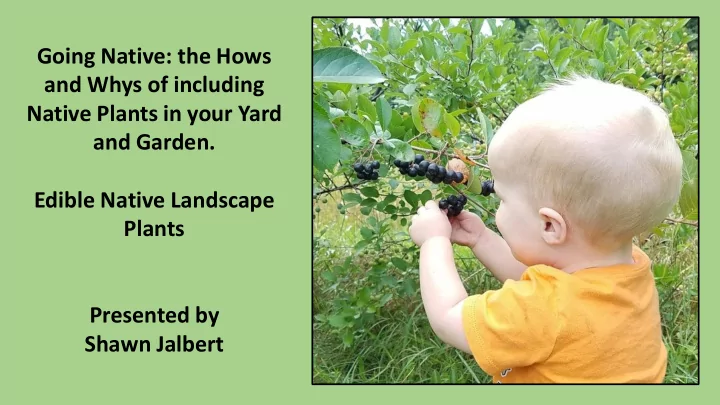

Going Native: the Hows and Whys of including Native Plants in your Yard and Garden. Edible Native Landscape Plants Presented by Shawn Jalbert
Acer rubrum & A. saccharum , Red & Sugar Maple Both red and sugar maples can be tapped for their sap, but sugar maples have a higher sugar content. Old school maple sap collection techniques using a sumac spile and a trough made from a hollowed out tree. You need about 40 gallons of sap to make 1 gallon of syrup.
Allium tricoccum, Ramps, Wild leeks Wild leeks are much revered for their distinctively flavored roots. Rare in Maine, wild populations are being sacked, prompting conservation concerns.
Amelanchier spicata , Running shadbush Shadbush fruit has a pleasantly sweet taste; it’s a good food source for humans Lots of flowers means lots of food for pollinators, as well and wildlife. as being pleasing to the human eye.
Aronia melanocarpa, Black chokeberry Chokeberry is a wonderfully adaptable plant--it can grow in inundated wetlands and bone dry fields and everywhere in between
Aronia melanocarpa, Black chokeberry Chokeberries have some of the highest antioxidant levels found in any fruit, thanks to that beautiful dark purple pigment. Chokeberries have been grown commercially in the former USSR region and eastern Europe since the late 1800’s The Soviets took interest in the fruit as a way to ensure a domestic supply of vitamin c. Chokeberry orchards have been established in the eastern US over the last decade or so, but market success has not been particularly stellar.
Betula papyrifera, White birch White birch can be tapped like a maple tree and its sap boiled down into a tasty syrup. Birch syrup is not common around here, probably because of the dominance of maple syrup, but is common in more northerly areas, like Alaska.
Carya ovata, Shagbark hickory Nut meat tastes very similar to walnut. Squirrels go “nuts” for these nuts and maniacally harvest as many as they can for winter storage.
Corylus americana, American hazlenut American hazelnut is the more prolific nut producer of the two species we have in Maine Does best in full sun conditions, accepting a variety of soil types.
Corylus cornuta, Beaked hazlenut Needs to be in at least part shade, nuts are fewer and smaller than those produced by American hazelnut.
Fragaria virginiana, Common strawberry Size doesn’t matter -even though the berries are small (about the size of your pinky fingernail), this strawberry made an important genetic contribution to modern strawberry cultivars. Fragaria virginiana was hybridized with other species to confer cold hardiness; allowing today’s large tasty strawberries to be grown well into northern area.
Gaylussacia baccata , Huckleberry It is arguable that huckleberries taste better than blueberries. Grows in a variety of contrasting habitats-rocky Red tinged flowers are a conversation piece when upland areas to soggy bogs. they come out in the spring.
Prunus maritima, Beach plum Can be eaten right off the bush, but the plums are not as sweet as you would expect them to be. Fruit makes excellent jellies and jams, which it is perhaps best known for in modern times.
Sambucus canadensis, Elderberry Elderberry is a rock star in every sense of the word. It has been recognized for centuries, and recently proven by modern science, as a having potent medicinal and nutritive value. The berries are high in beneficial antioxidants, vitamins, and minerals. Elderberry extracts provide relief from colds and the flu, thanks to its anti- viral and anti-bacterial properties. Berries can be made into wine and jam. Pigment is used to provide stable purple color to food products.
Sambucus canadensis, Elderberry This large handful of berries is from one of the many elderberry cultivars that have been Laden with berries, this plant was growing in the wild. developed over the last century. Taken at Longwood Gardens trial planting in PA.
Vaccinium angustifolium, Lowbush blueberry Tolerant of poor sandy soils, lowbush blueberry can be used as a ground cover in sunny spots.
Vaccinium corymbosum, Highbush blueberry Sweet-tart berries; commercial highbush blueberry cultivars were selected from this native shrub and are now grown all over the world. Found growing in wetlands in the wild.
Vaccinium macrocarpon , Cranberry In the wild they are a denizen of sphagnum Cranberries aren’t so good picked right off moss bogs, but they do surprisingly well the plant, they are very tart with not when planted in upland gardens. enough sweet. But we know how good they are when a bit of sugar is added….
Vitis labrusca, Fox grape Fox grape is the wild parent of the famous Concord grape, grown for its wonderful tasting juice.
Vitis riparia, River grape This species bears many more, albeit smaller, grapes on each cluster then fox grape. Grapes are sour to the human palate, but many species of wildlife are nourished by the fruit. Leaves and tendrils are edible before they become fully mature and too woody.
Shawn Jalbert is the principle of Native Haunts Located in Alfred, Maine 207-604-8655 www.nativehaunts.com nativehaunts@gmail.com Native Haunts offers the following- Products Native trees, shrubs and perennials of local provenance. Locally collected seed of native trees, shrubs and perennials. Consultation services Identification of native plants on your property. Integrating native plants into your landscape plan. Identification and control strategies for invasive plants.
Recommend
More recommend